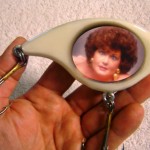chesapeake bay
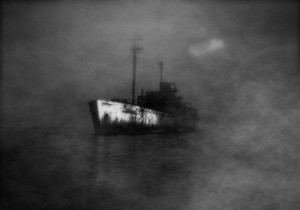 The night was as dark as a tomb and I was wet and cold. I felt lucky to be alive and I couldn’t believe my good fortune in finding a tattered blanket in this rusted ship’s hold. I pulled it higher over my shoulders and dozed.
The night was as dark as a tomb and I was wet and cold. I felt lucky to be alive and I couldn’t believe my good fortune in finding a tattered blanket in this rusted ship’s hold. I pulled it higher over my shoulders and dozed.
We shouldn’t have tried to fish today. The weather forecast called for building winds, but we thought we could get out for a few hours to catch some of the big stripers that always migrate into the Chesapeake Bay in late October. The blow arrived soon after we launched into the Honga River from the Hoopersville ramp. By the time we rounded Nancy’s Point into the main stem of the Bay, we were well into the teeth of a full northwestern gale. We decided to call it off, but just as my friend Phil turned his center console back east toward the river, a rogue wave hit us broadside. The boat rolled hard and I went overboard. Read More!
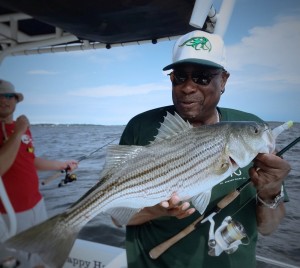 I got to fish with Dusty Baker. If the name doesn’t mean anything to you then you must be living with the sea bass underneath the reef balls off Tilghman Island. Dusty Baker is nothing short of baseball royalty. He’s the manager of the Washington Nationals, former manager of both the Chicago Cubs and San Francisco Giants, and All Star outfielder for the Atlanta Braves and Los Angeles Dodgers. I couldn’t hope to list all his accomplishments but the most important statistic relative to Chesapeake Bay fishing is that he’s caught thousands of striped bass and other species. Dusty has fished all his life, on both U.S. coasts and all over the Caribbean as well as in other parts of the world. He’s a pro with a fly rod, a spinning outfit, and a baitcaster.
I got to fish with Dusty Baker. If the name doesn’t mean anything to you then you must be living with the sea bass underneath the reef balls off Tilghman Island. Dusty Baker is nothing short of baseball royalty. He’s the manager of the Washington Nationals, former manager of both the Chicago Cubs and San Francisco Giants, and All Star outfielder for the Atlanta Braves and Los Angeles Dodgers. I couldn’t hope to list all his accomplishments but the most important statistic relative to Chesapeake Bay fishing is that he’s caught thousands of striped bass and other species. Dusty has fished all his life, on both U.S. coasts and all over the Caribbean as well as in other parts of the world. He’s a pro with a fly rod, a spinning outfit, and a baitcaster.
We caught a lot of fish while he was staying in St. Michael’s, Maryland over the All-Star break, but my most memorable few minutes came while we were sitting in the back of Chuck Castle’s Whaler and reminiscing about fishing with our fathers. Dusty and I found that we have a lot in common in that both of our dads were very active in fundamentalist Christian congregations (his father a Baptist deacon and mine a Church of Christ minister), and that they both loved to fish. As we swapped stories about our younger days, the conversation eventually came around to our fathers’ favorite fish. “Shellcrackers,” we said at the same time. If you know anything about southern fishing and those hard-fighting redear sunfish, that coincidence won’t surprise you at all. Read More!
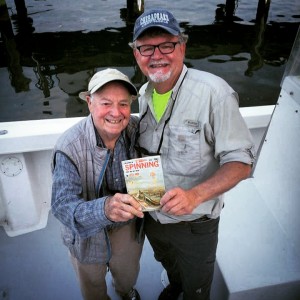 A lot has been written about the art in fly fishing. There is grace and beauty in a perfect fly cast. What is more satisfying than watching a colorful trout rise from a crystal clear pool to take a hand-tied floating fly? I just returned from Colorado where I had ample time to fly fish in the cold streams of the Gunnison National Forest. I don’t get to fly fish for trout much, but when I do, I’m always struck by the similarities to light tackle casting for rockfish on the Chesapeake Bay. One of the most important aspects of fly fishing is the ability to read the water and cast to where the fish are. Another is presenting the lure naturally so that it moves at the exact same speed as the current. While we don’t hear about it as much, there is comparable art in light tackle casting, even when it’s done with a spinning outfit or a baitcaster.
A lot has been written about the art in fly fishing. There is grace and beauty in a perfect fly cast. What is more satisfying than watching a colorful trout rise from a crystal clear pool to take a hand-tied floating fly? I just returned from Colorado where I had ample time to fly fish in the cold streams of the Gunnison National Forest. I don’t get to fly fish for trout much, but when I do, I’m always struck by the similarities to light tackle casting for rockfish on the Chesapeake Bay. One of the most important aspects of fly fishing is the ability to read the water and cast to where the fish are. Another is presenting the lure naturally so that it moves at the exact same speed as the current. While we don’t hear about it as much, there is comparable art in light tackle casting, even when it’s done with a spinning outfit or a baitcaster.
In my years of fishing both fresh and saltwater, I’ve had opportunities to observe the skills and artistry of some of the finest anglers in the world. As a teenager, I guided some of the best-known bass pros in the country when they practiced for tournaments in my home lakes in Tennessee. I’ve been fortunate enough to wade the pristine streams of the Smoky Mountains with the most knowledgeable anglers in the business, and I’ve fished for bonefish and pompano with the legendary guide families of the Bahamas. Most recently, I was joined on my boat Thunder Road by one of the best-known anglers in the world: the legendary Lefty Kreh. Lefty has been fishing for almost a half century longer than I’ve been alive. He’s forgotten more in his 92 years than I can ever hope to learn.
We caught all the fish we wanted that day, and enjoyed several hours of inspiring conversation. Lefty’s fly casting skills are legendary, but his prowess with a spinning outfit is less well-known. Between hooksets, we talked about casting and jigging techniques as well as patterns and the best ways to approach fishing spots. At one point, the conversation turned to the art in fishing. I’m happy to say that after listening to Lefty’s jokes, advice, and aphorisms refined over his long life of fishing, I came away a better fisherman and, hopefully, a better person.
Here are some of the thoughts I’ve collected about the art in light tackle casting: Read More!
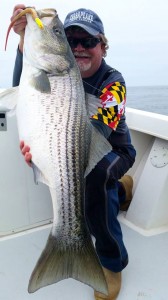 If fishing can be a feast or famine activity, anglers in the Chesapeake Bay region have been eating high on the hog lately. As is typical with April, all good things happen at once. In the past two weeks, I’ve caught shad, white perch, yellow perch, bass, bluegill, crappie, catfish, and stripers. Throw in the walleye and snakeheads my friends are catching, and we’re smack in the middle of a virtual smorgasbord of good fishing. The weather has been spotty, but that hasn’t kept too many anglers off the water. Here’s my report:
If fishing can be a feast or famine activity, anglers in the Chesapeake Bay region have been eating high on the hog lately. As is typical with April, all good things happen at once. In the past two weeks, I’ve caught shad, white perch, yellow perch, bass, bluegill, crappie, catfish, and stripers. Throw in the walleye and snakeheads my friends are catching, and we’re smack in the middle of a virtual smorgasbord of good fishing. The weather has been spotty, but that hasn’t kept too many anglers off the water. Here’s my report:
Yellow Perch: It’s all but over now, but we enjoyed one of the best March ring-perch runs in recent memory. Neds ran big this year and they were plentiful. They were also a little earlier than usual. That made it nice for those of us who were just about going crazy with cabin fever. Most of my fishing was in the Eastern Shore creeks and rivers. I fished Tuckahoe Creek and the Choptank River from Denton up to Red Bridges park. Some days it was one fish after another and on other days it was slow. Yellow perch can be finicky at times. When they are spawning they typically move up the streams in waves. If you aren’t catching, stick around because chances are another wave will move through and you’ll start getting bites again. See my earlier post for more information about the yellow perch run.
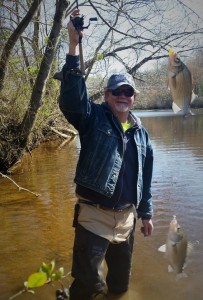 White Perch: I thought the white perch spawn might be over until I got a call from my friend Phil Kerchner last week. He was still lighting up the black backs in the creeks near his place at Wye Mills. I called him last Sunday and we met on the banks of Tuckahoe Creek. It was one pre-spawn white perch after another for a little while. Our best lures were Bust ‘Em Baits stingers and small twister tails rigged in tandem on one-sixteenth-ounce jig heads. As the tide changed, the bite slowed down, but it picked back up before sunset and we took home a very nice stringer. White perch are my favorite fish to eat. I even prefer them over crappie and I think they’re way better than yellow perch. All things in moderation of course, but don’t feel bad about keeping what you want to eat because white perch aren’t threatened and they reproduce prolifically. They will generally hang around the spawning grounds for a little while after they spawn, so I wouldn’t be surprised if we keep catching them in the creeks for a couple of more weeks. After that, they’ll spread out along the shorelines where they can be targeted all summer long.
White Perch: I thought the white perch spawn might be over until I got a call from my friend Phil Kerchner last week. He was still lighting up the black backs in the creeks near his place at Wye Mills. I called him last Sunday and we met on the banks of Tuckahoe Creek. It was one pre-spawn white perch after another for a little while. Our best lures were Bust ‘Em Baits stingers and small twister tails rigged in tandem on one-sixteenth-ounce jig heads. As the tide changed, the bite slowed down, but it picked back up before sunset and we took home a very nice stringer. White perch are my favorite fish to eat. I even prefer them over crappie and I think they’re way better than yellow perch. All things in moderation of course, but don’t feel bad about keeping what you want to eat because white perch aren’t threatened and they reproduce prolifically. They will generally hang around the spawning grounds for a little while after they spawn, so I wouldn’t be surprised if we keep catching them in the creeks for a couple of more weeks. After that, they’ll spread out along the shorelines where they can be targeted all summer long.
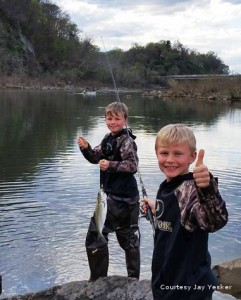 Shad: The shad run is in full swing. I’ve fished the Potomac around Fletcher’s Cove and Chain Bridge twice now and found shad in good numbers both times. Joe Yack is reporting shad in the Susquehanna now as well. The good news is that hickory shad are running big this year. I’ve seen at least two reports of hicks approaching five pounds. Some anglers mistakenly identify bigger hickory shad as white (American) shad because, when they are fully mature, they lose the spots on their shoulders. The key to identifying shad is to look at the lower jaw. If the lower jaw projects beyond the upper one with the mouth closed, it’s a hickory. I typically cast one-quarter or one-eighth ounce shad darts. It pays to experiment when you’re shad fishing because the same colors and techniques that work one day might not work the next. Last week, my fishing buddy Jay Yesker out-fished me by snap-jigging two quarter-ounce darts on eight-pound-test monofilament. (That’s Jay’s boys in the picture.) The fish were taking on the fall. Since my usual spinning rig is eight-pound-test braid with a similar size fluorocarbon leader, I couldn’t duplicate what he was doing because the force of the snap using the stretchless braid would break my leader. You can bet I was rigged with mono the next time I went out, but wouldn’t you know it, on that day the fish wanted a steady fast retrieve! You just don’t know until you go. The shad run should last for several more weeks, so there’s still plenty of time to get in on the action. Read More!
Shad: The shad run is in full swing. I’ve fished the Potomac around Fletcher’s Cove and Chain Bridge twice now and found shad in good numbers both times. Joe Yack is reporting shad in the Susquehanna now as well. The good news is that hickory shad are running big this year. I’ve seen at least two reports of hicks approaching five pounds. Some anglers mistakenly identify bigger hickory shad as white (American) shad because, when they are fully mature, they lose the spots on their shoulders. The key to identifying shad is to look at the lower jaw. If the lower jaw projects beyond the upper one with the mouth closed, it’s a hickory. I typically cast one-quarter or one-eighth ounce shad darts. It pays to experiment when you’re shad fishing because the same colors and techniques that work one day might not work the next. Last week, my fishing buddy Jay Yesker out-fished me by snap-jigging two quarter-ounce darts on eight-pound-test monofilament. (That’s Jay’s boys in the picture.) The fish were taking on the fall. Since my usual spinning rig is eight-pound-test braid with a similar size fluorocarbon leader, I couldn’t duplicate what he was doing because the force of the snap using the stretchless braid would break my leader. You can bet I was rigged with mono the next time I went out, but wouldn’t you know it, on that day the fish wanted a steady fast retrieve! You just don’t know until you go. The shad run should last for several more weeks, so there’s still plenty of time to get in on the action. Read More!
 Have you ever belly-crawled through the tall grass beside a mountain stream hoping to sneak up on your favorite fishing spot? Most freshwater anglers understand how important it is to be quiet and sneaky but I’ve noticed that some Chesapeake Bay fishermen don’t fully appreciate the concept of stealth. It won’t be long until the weather breaks and fishermen who are looking to overcome cabin-fever will pack into some of the better-known fishing spots like the warm water discharges, the Susquehanna Flats, and the mouths of Upper Bay rivers. When fish are thick and hungry, you can stomp beer cans in the bottom of your boat and still catch them, but when they’re finicky, stealth becomes a lot more important.
Have you ever belly-crawled through the tall grass beside a mountain stream hoping to sneak up on your favorite fishing spot? Most freshwater anglers understand how important it is to be quiet and sneaky but I’ve noticed that some Chesapeake Bay fishermen don’t fully appreciate the concept of stealth. It won’t be long until the weather breaks and fishermen who are looking to overcome cabin-fever will pack into some of the better-known fishing spots like the warm water discharges, the Susquehanna Flats, and the mouths of Upper Bay rivers. When fish are thick and hungry, you can stomp beer cans in the bottom of your boat and still catch them, but when they’re finicky, stealth becomes a lot more important.
Spring on the Chesapeake Bay is the best time of year to catch the fish of a lifetime, but don’t forget that big fish get that way by being smart. While you might luck into a forty-inch-plus fish once in a while no matter what, your chances increase dramatically when you improve your noise discipline. Here are some tips and tactics that are guaranteed to increase your odds of catching trophy stripers on light tackle: Read More!
Hey guys, it won’t be long before Santa soars over the Chesapeake Bay in his reindeer-powered center console. Let’s face it, most of us still have some shopping to do for that special lady on our list. While most Internet gift guides will suggest you buy her bracelets, earrings, or pretty clothes for Christmas, I’ve collected some fishing-related stocking stuffers that are guaranteed to please.* Included are useful links so you can buy them online right away!

9. I’d Rather Be F___ING t-shirt: Comes in men’s and ladies’ sizes, perfect for those early mornings when you wake up five minutes before the alarm goes off and need to signal your intentions before you head off to the lake. Comes with a dry erase marker for added versatility. Trust me, chicks dig shirts like this one.



